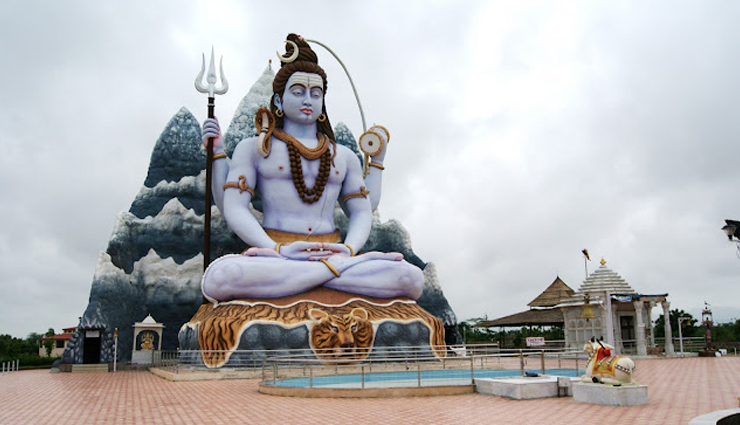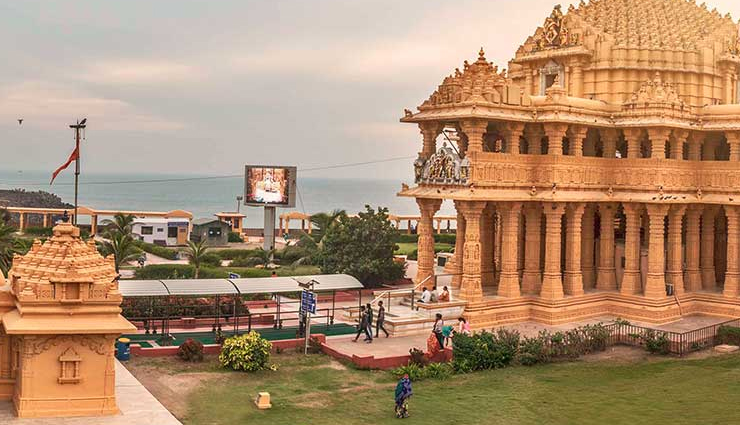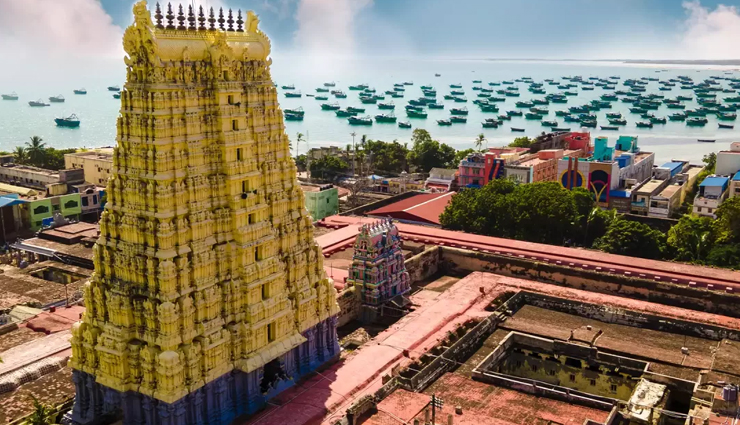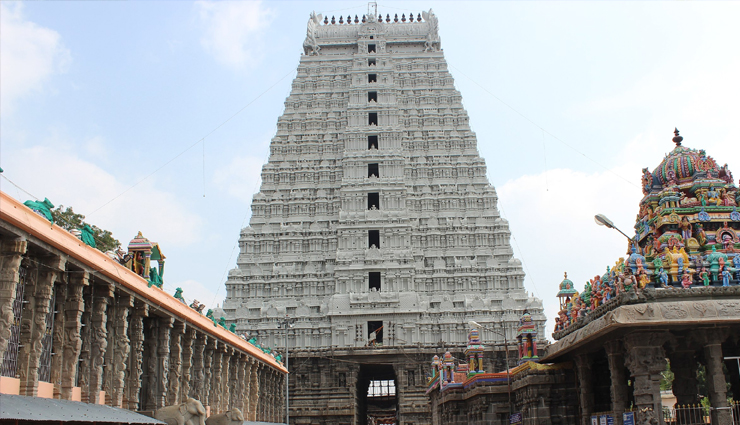7 Famous Lord Shiva Temples To Visit During Savan In India
By: Priyanka Maheshwari Wed, 05 July 2023 3:38:13

Lord Shiva is a prominent deity in Hinduism, and there are numerous temples dedicated to him across India and in various parts of the world. Shiva temples serve as places of worship, spiritual gathering, and pilgrimage for devotees of Lord Shiva. Here are some general characteristics and aspects of Lord Shiva temples:
1. Architecture and Iconography: Shiva temples exhibit diverse architectural styles, reflecting the rich cultural heritage of the region in which they are located. The main shrine typically houses a Shivalinga, a symbolic representation of Lord Shiva, along with statues or depictions of his various forms and manifestations.
2. Jyotirlingas: There are twelve Jyotirlingas, which are considered highly sacred representations of Lord Shiva. These are believed to be self-manifested lingas imbued with divine power. Each Jyotirlinga has its own temple dedicated to Lord Shiva and attracts a significant number of devotees.
3. Rituals and Offerings: Devotees engage in various rituals and practices within Shiva temples, including abhishekam (ceremonial bathing of the Shivalinga with sacred substances), arati (waving of lamps), and recitation of mantras. Offerings like flowers, bilva leaves, milk, and fruits are made to Lord Shiva.
4. Festivals: Shiva temples celebrate festivals dedicated to Lord Shiva, such as Maha Shivaratri, which is considered the most significant festival honoring Lord Shiva. Devotees engage in fasting, night-long vigils, and special prayers during these occasions.
5. Pilgrimage Sites: Some Shiva temples are revered as major pilgrimage sites due to their historical and spiritual significance. Examples include the Kashi Vishwanath Temple in Varanasi, Uttar Pradesh, and the Amarnath Cave Temple in Jammu and Kashmir.
6. Sacred Geography: Shiva temples are often located in places considered spiritually significant, such as along rivers, atop mountains, or in forests. These natural surroundings enhance the divine aura and provide an atmosphere conducive to meditation and spiritual contemplation.
It's important to note that each Shiva temple has its unique characteristics and cultural practices, and their significance can vary depending on regional traditions and legends associated with Lord Shiva.
India is home to numerous famous Lord Shiva temples that hold immense spiritual and cultural significance. Here are some of the well-known Lord Shiva temples in India:

# Kashi Vishwanath Temple, Varanasi, Uttar Pradesh
Kashi Vishwanath Temple, located in the ancient city of Varanasi, Uttar Pradesh, is one of the most revered and sacred temples dedicated to Lord Shiva in India. It holds immense religious significance and is considered one of the holiest pilgrimage sites for Hindus.
The temple is situated along the banks of the sacred Ganges River and is believed to be the abode of Lord Shiva, the destroyer and transformer in the Hindu pantheon. The presiding deity of the Kashi Vishwanath Temple is known as Vishwanath, which translates to "Lord of the Universe," signifying the supreme power of Shiva.
The architecture of the temple showcases intricate details and craftsmanship, reflecting the rich cultural heritage of Varanasi. The main sanctum sanctorum houses the lingam, the symbolic representation of Lord Shiva, which is adorned with offerings and flowers by devotees.
The Kashi Vishwanath Temple attracts thousands of pilgrims and devotees from all over the world who seek the blessings and divine presence of Lord Shiva. The temple complex is known for its spiritual ambiance, where devotees engage in various rituals, prayers, and aarti (ceremonial worship) ceremonies throughout the day.

# Somnath Temple, Somnath, Gujarat
The Somnath Temple, located in the small town of Somnath in Gujarat, India, is a revered and ancient temple dedicated to Lord Shiva. It is one of the twelve Jyotirlingas (divine pillars of light) that are believed to be the most sacred abodes of Lord Shiva.
Situated on the western coast of Gujarat, overlooking the Arabian Sea, the Somnath Temple holds immense religious and historical significance. The temple has been destroyed and rebuilt several times throughout history, with the current structure being reconstructed in the Chalukya style of architecture.
The temple's name, "Somnath," translates to "Lord of the Moon," symbolizing the connection between Lord Shiva and the moon. The presiding deity of the temple is Lord Shiva in the form of a lingam, a symbolic representation of his cosmic power and divinity.
The Somnath Temple attracts a large number of devotees and tourists throughout the year who come to seek blessings, witness the religious rituals, and experience the spiritual aura of the temple. The magnificent architecture, intricate carvings, and serene surroundings create a tranquil atmosphere that adds to the sanctity of the place.
The temple complex includes various other shrines dedicated to different deities, such as Lord Ganesha, Goddess Parvati, and Lord Krishna. The beautiful gardens and the serene beach nearby add to the overall charm of the temple premises.

# Kedarnath Temple, Kedarnath, Uttarakhand
Kedarnath Temple, located in the picturesque town of Kedarnath in the state of Uttarakhand, India, is one of the most revered Hindu pilgrimage sites in the country. It holds immense spiritual significance and is dedicated to Lord Shiva, one of the principal deities in the Hindu pantheon.
Situated amidst the breathtaking Himalayan ranges, at an elevation of approximately 3,583 meters (11,755 feet) above sea level, the Kedarnath Temple is nestled in the Garhwal region. It is part of the Char Dham Yatra, which is a pilgrimage circuit that includes the four sacred sites of Yamunotri, Gangotri, Kedarnath, and Badrinath.
The temple is believed to have been built by the Pandavas, the mythological heroes of the Indian epic, Mahabharata. It is considered one of the twelve Jyotirlingas, which are believed to be the most sacred abodes of Lord Shiva. According to Hindu mythology, Kedarnath is the place where Lord Shiva granted salvation to the Pandavas.
The journey to Kedarnath Temple is an arduous one, requiring a trek of approximately 16 kilometers (10 miles) from the town of Gaurikund. The path winds through scenic landscapes, snow-clad mountains, and picturesque valleys, offering breathtaking views along the way.
The main sanctum sanctorum of the temple houses a lingam, the symbolic representation of Lord Shiva. The temple's architecture showcases intricate stone carvings and reflects the traditional Himalayan style. The serene and tranquil atmosphere of the temple adds to its spiritual aura.

# Mahakaleshwar Temple, Ujjain, Madhya Pradesh
Mahakaleshwar Temple, located in the ancient city of Ujjain in Madhya Pradesh, India, is one of the most renowned and revered Hindu temples dedicated to Lord Shiva. It holds great religious significance and is considered one of the twelve Jyotirlingas, which are believed to be the most sacred abodes of Lord Shiva.
Situated on the banks of the holy Shipra River, the Mahakaleshwar Temple stands as a symbol of divinity and spirituality. The temple's name, "Mahakaleshwar," translates to "Great Lord of Time," signifying the eternal and timeless nature of Lord Shiva.
The temple is known for its distinctive architecture, which showcases intricate stone carvings and sculptures. It has multiple levels and spires, with the central shrine housing the lingam, the symbolic representation of Lord Shiva. The lingam is believed to be a swayambhu, meaning it manifested itself naturally.
One of the unique aspects of the Mahakaleshwar Temple is the daily ritual of "Bhasma Aarti," where the lingam is adorned with sacred ashes (bhasma) and is worshipped with great devotion and reverence. The temple complex also houses smaller shrines dedicated to various deities, including Goddess Parvati and Lord Ganesh.
The Mahakaleshwar Temple attracts a large number of devotees and pilgrims throughout the year, especially during the auspicious occasion of Maha Shivaratri. During this festival, the temple witnesses a grand celebration and fervent worship, creating a vibrant and spiritually charged atmosphere.

# Ramanathaswamy Temple, Rameswaram, Tamil Nadu
Ramanathaswamy Temple, located in the town of Rameswaram in the southern state of Tamil Nadu, India, is one of the most significant Hindu temples dedicated to Lord Shiva. It is renowned for its rich historical and religious importance and is considered one of the Char Dhams, the four sacred pilgrimage sites for Hindus.
The temple is situated on Rameswaram Island, which is separated from mainland India by the Pamban Channel. It is believed to be the place where Lord Rama, the central figure of the Hindu epic Ramayana, built a bridge to Sri Lanka and worshipped Lord Shiva to seek forgiveness for the act of killing Ravana, the demon king of Lanka.
The Ramanathaswamy Temple is famous for its magnificent architecture, intricate carvings, and vast temple complex. The temple's architecture showcases the Dravidian style, with towering gopurams (entrance towers) adorned with detailed sculptures depicting various mythological stories and deities.
The main sanctum sanctorum of the temple houses the lingam, the symbolic representation of Lord Shiva. The temple is known for its 22 sacred wells, where pilgrims take ritual baths before offering prayers. The most prominent of these wells is the Agni Theertham, located on the beach, which is believed to have the power to cleanse sins.
One of the significant rituals at the Ramanathaswamy Temple is the recitation of the Ramayana, the ancient Hindu epic, which takes place daily. The temple also hosts various festivals throughout the year, with the most important being the Maha Shivaratri festival, which draws thousands of devotees from different parts of the country.

# Mallikarjuna Temple, Srisailam, Andhra Pradesh
Mallikarjuna Temple, situated in the town of Srisailam in the state of Andhra Pradesh is a revered Hindu temple dedicated to Lord Shiva. It is one of the twelve Jyotirlingas, which are considered to be the most sacred abodes of Lord Shiva.
Perched on the Nallamala Hills on the banks of the Krishna River, the Mallikarjuna Temple holds great religious significance and attracts a large number of devotees and pilgrims from across the country. It is believed to be one of the oldest temples in South India and has a rich historical and mythological background.
The temple is known for its stunning architecture, intricate carvings, and a blend of Dravidian and Chalukyan architectural styles. The main sanctum sanctorum houses the lingam, representing Lord Mallikarjuna, while the temple complex also includes shrines dedicated to other deities, such as Goddess Bhramarambika (an incarnation of Goddess Parvati) and Lord Ganesha.
Srisailam is considered a significant pilgrimage site due to its association with various mythological legends and historical events. The town is mentioned in ancient Hindu scriptures, including the Puranas, and is believed to be the place where Lord Shiva and Goddess Parvati performed their cosmic dance, known as the Kalyana Mahotsavam.
Apart from its religious significance, Srisailam is also known for its picturesque surroundings, with lush green forests and scenic beauty. The temple's location amidst the Nallamala Hills adds to its serene and tranquil ambiance, providing devotees with a spiritual retreat.

# Annamalaiyar Temple, Thiruvannamalai, Tamil Nadu
Annamalaiyar Temple, located in the town of Thiruvannamalai in the state of Tamil Nadu is a renowned Hindu temple dedicated to Lord Shiva. It is one of the largest and most ancient temples in the country and holds great religious significance among devotees.
Situated at the base of the sacred Arunachala Hill, the Annamalaiyar Temple is believed to be one of the Pancha Bhoota Stalams, representing the element of fire. The temple complex covers a vast area and is known for its impressive architecture, intricate carvings, and towering gopurams (entrance towers) that reach staggering heights.
The main deity of the temple is Lord Annamalaiyar, a form of Lord Shiva, who is worshipped with great devotion. The sanctum sanctorum houses the lingam, symbolizing the divine presence of Lord Shiva. The temple also encompasses several other shrines dedicated to various deities, including Goddess Parvati, Lord Ganesh, and Lord Murugan.
One of the significant attractions of the Annamalaiyar Temple is the annual festival of Karthigai Deepam, which is celebrated with grandeur and enthusiasm. During this festival, a massive lamp called the Mahadeepam is lit atop the Annamalai Hill, creating a mesmerizing sight that attracts thousands of devotees and tourists.
Thiruvannamalai is considered a sacred place for devotees and spiritual seekers. The town is closely associated with the renowned saint, Sri Ramana Maharshi, who spent most of his life in the vicinity of the Arunachala Hill. The tranquil and serene atmosphere of Thiruvannamalai adds to the spiritual ambiance of the temple, offering a conducive environment for meditation and self-reflection.





